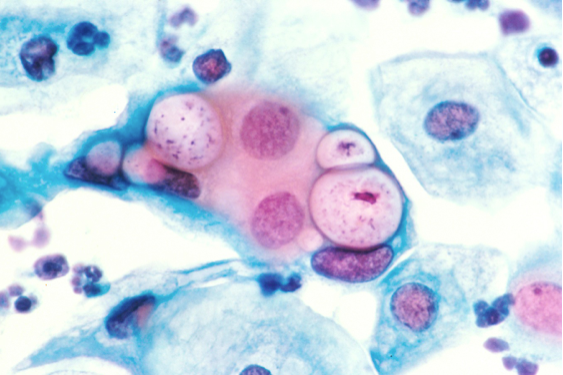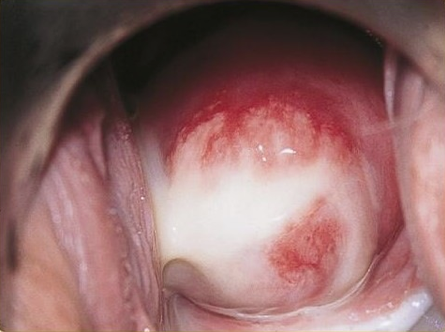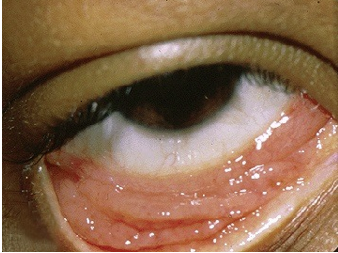This website uses cookies so that we can provide you with the best user experience possible. Cookie information is stored in your browser and performs functions such as recognising you when you return to our website and helping our team to understand which sections of the website you find most interesting and useful.
Chlamydia Symptoms – The Tell-Tale Signs
Chlamydia is sometimes referred to as the silent sexually transmitted infection as for most people; there are no outward symptoms to suggest that it is there. However, there are some signs that you can look out for that you may have the infection.

Chlamydia cells collected from the cervix with a swab
The symptoms of the infection will differ between men and women. Chlamydia also develops differently in different parts of the body, so there are quite a few signs and symptoms to be on the look-out for to suggest that you may have been exposed to the infection.
When will symptoms appear?
If you get symptoms of the Chlamydia infection, it will usually be one to three weeks after having unprotected sex with someone who also has the infection.
For others, symptoms can appear many months later. Chlamydia can spread, causing secondary infections. It is sometimes when this happens that symptoms finally appear.
You should not wait until you develop symptoms before getting a Chlamydia test. Most people will never see any kind of signs (14 Signs of Chlamydia) of the infection. If you’ve had unprotected sex with a partner or have recently changed your partner, it pays to get checked out to make sure that you are in good health.
Symptoms in women
While only 20-30 per cent of women will develop symptoms following infection with the Chlamydia bacteria, those who do have them will notice a number of common symptoms that can be uncomfortable and sometimes embarrassing.
One of the common symptoms for women is pain when urinating, or peeing. With the vagina and the urethra, through which urine is passed, being so close together in women, the Chlamydia infection can often affect the urethra causing swelling and pain. There are other types of infection that could cause this too, such as a more general Urinary Tract Infection or UTI, which can be caused by a range of different bacteria.
Some women notice a change in their vaginal discharge (15 A Guide to Discharge from Chlamydia) when they have a Chlamydia infection. Any change in the usual secretions, which are normally clear or slightly milky and generally odourless, should be checked out by a healthcare practitioner as they could indicate a number of problems that may require treatment.

The inflamed cervix of a woman with Chlamydia. The milky discharge would be an outward sign of the infection.
If left untreated, often because of the absence of symptoms immediately after infection, Chlamydia can cause Pelvic Inflammatory Disease (PID), which in itself has a range of symptoms. If you experience pain in the lower abdomen, pain or bleeding during or after sex, bleeding between periods or heavier periods than is usual for you, make an appointment for an examination and get a Chlamydia test to rule out the infection as a cause of the symptoms.
Symptoms in men
Men are slightly more likely than women to experience symptoms as a result of Chlamydia infection. You have around a 50:50 chance of having some kind of indication that you have the infection if you are male with some key signs to look out for.
As with women, one of the top indicators of a potential Chlamydia infection is pain when urinating. For men, the urethra performs a sexual function as well as being used to pee, so inflammation caused by Chlamydia is more likely to show up in the form of this kind of pain.
Pain from the inflammation caused by Chlamydia infection can also spread to the testicles. One of the common complications of Chlamydia in men if left untreated is testicular swelling and pain, also known as orchiditis.
Men can also develop a discharge from the tip of the penis as a result of the infection. The discharge is likely to be clear, watery or sometimes slightly cloudy. Unless aroused, men do not usually experience discharge from the penis unless there is an underlying problem, so if you notice this it’s important to get it checked out.
Other symptoms
Chlamydia does not only affect the genitals. The infection can be passed on through other routes too and can cause symptoms in any affected area.
If you have had unprotected anal sex with a partner who has Chlamydia, the infection can develop in the rectum. The symptoms likely to be experienced from this type of infection are pain, bleeding, general discomfort or bleeding – either when you go to the toilet or in general. These kinds of symptoms can also be indicative of other conditions such as haemorrhoids or even bowel cancer, so if you have any concerns you should get checked out straight away.

Chlamydial Conjunctivitis
The eyes are particularly susceptible to Chlamydia infection, and if semen or vaginal fluids from someone with the infection come into contact with the eyes, it can result in Chlamydial Conjunctivitis. This is easily treated with antibiotics (6 Chlamydia antibiotics), as with the infection in any other site in the body, but if left untreated can cause blindness.
Chlamydia can be passed on through unprotected oral sex and the bacteria can colonise the throat. This does not usually produce any symptoms in itself but can act as a breeding ground for the bacteria which can then be passed on to a sexual partner through oral sex.
The biggest clue
As large numbers of people with a Chlamydia infection (Hub page) do not develop symptoms, clues as to the presence of the infection often have to come from a different source. Having unprotected sex with a new partner or one who has been diagnosed with the infection are key signs that you too may have Chlamydia. In these circumstances, it’s important that you get tested and treated before the infection can cause some of the long-term damage its capable of if left untreated.
Conclusion
Chlamydia can cause symptoms of the infection in some people, but not all. It is always important to know and understand your body so you can be aware of any changes in your usual state of health. The only way to be absolutely sure that you are not carrying the infection is to make sure that you are tested regularly for Chlamydia along with a range of other sexually transmitted infections so you stay healthy.



